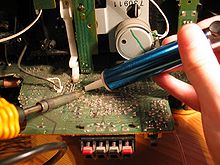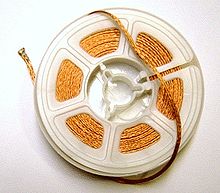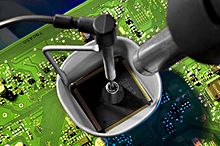- Desoldering
-
In electronics, desoldering is the removal of solder and components from a circuit for troubleshooting, for repair purposes, component replacement, and to salvage components. Electronic components are often mounted on a circuit board, and it is usually desirable to avoid damaging the circuit board, surrounding components, and the component being removed.
Specialized tools, materials, and techniques have been devised to aid in the desoldering process.
Contents
Tools
Desoldering tools and materials include the following:
- Solder wick
- Heat guns
- Desoldering pump
- Removal alloys
- Removal fluxes
- Vacuum and pressure pumps with specialized heater tips and nozzles
- Rework stations, used to repair printed circuit boards that fail factory test.
Desoldering pump
A desoldering pump, colloquially known as a solder sucker, is a device which is used to remove solder from a printed circuit board. There are two types: the plunger style and bulb style.[1]
The plunger style is usually a small, spring-loaded device that sucks the solder off the soldered connection. It is applied to a heated solder connection, then the user activates the device (usually via button) to suck the solder away. Other models use a powered vacuum pump instead of spring to generate the vacuum. These pumps are less likely to damage fragile surface-mount components because they have a constant air flow, instead of the sudden, strong air flow of a spring-loaded type.[citation needed]
The bulb style works much like the plunger style, except a bulb is used to create the vacuum. A desoldering iron is a soldering iron with a desoldering bulb attached to it.[1]
Solder wick
A solder wick, also known as a desoldering wick or desoldering braid, is a roll of fine, braided 18 to 42 AWG wire typically made from oxygen free copper that has been treated with a rosin solder flux.
The processes of removing solder with a wick starts by placing the wick over the solder to be removed and then heating the portion of the wick in contact with the joint with a soldering iron. As the solder wick is heated and the solder reaches its melting point the solder is sucked into the solder wick via capillary action. The solder wick is then removed along with the heat and the solder is allowed to solidify within the wick, apart from the workpiece. Finally, the used section of wick is discarded.
Technique
Desoldering requires application of heat to the solder joint and removing the molten solder so that the joint may be separated. Desoldering may be required to replace a defective component, to alter an existing circuit, or to salvage high value components for possible re-use. Excess application of heat may damage electronic components or destroy the bond between a printed circuit trace and the underlying substrate.
A single joint can usually be quickly undone with a soldering iron and the use of either vacuum bulb, plunger, or desoldering braid. Once the solder has been melted, the vacuum device is applied to withdraw solder from the joint by a rapid movement of air. Desoldering braid draws up the molten solder by capillary action; the braid usually contains the same flux as solder.
Multiple-lead devices require special care in removal. For through-hole mounted devices, special soldering bits that facilitate even distribution of heat over all the leads at one time can be used. For factory re-work, a temperature controlled rework station may contain such bits, hot-air systems, and a vacuum system to facilitate removal of the part. Large surface-mounted components require special tooling for production desoldering, although various and improvised methods can be successfully applied for field service. In some instances it is better to destroy the part by cutting off its leads and removing the leads individually, instead of risking damage to the printed circuit board.
Hobbyists may even use a torch or hot air gun to rapidly heat all parts on a board and remove them; such methods are extremely difficult to apply without damaging parts or boards and may result in toxic fumes. Of course, all soldering work (with flux) involves some amount of toxic fumes, which is why ventilation is important.
Quad flat packages
Quad Flat Package (QFP) chips have thin leads closely packed together protruding from the four sides of the integrated circuit (IC); usually a square IC. Removal of these chips can be problematic as it is impossible to heat all of the leads at once with a standard soldering iron. It is possible to remove them with the use of a razor blade or a high-rpm craft tool, simply by cutting off the leads. The stubs are then easy to melt off and clean with a soldering iron. Obviously this technique entails the destruction of the IC. Another method is to use a heat gun or pencil butane torch and heat up a corner, and gently pry it off, working the torch down the leads. This method often leads to traces getting lifted off the PCB where a lead did not get heated enough to cause the solder to flow.
A system under the JBC brand uses extractor shields that concentrates heat where it needs to be, protect surrounding components and avoids damage to the board or the QFP. The system takes advantage of the properties of solder by melting it with hot air. The extractor has a spring system that gently pulls the IC upward when the liquid stage of solder has been reached. The IC is held by a vacuum nozzle similar to the ones used in pick & place machines. This system prevents damage to the pads on the PCB, the IC, avoids over-heating surrounding components and blowing them off and also removes the risk of having operator errors by using tweezers or other tools that damage the PCB or IC.
Another way to remove one of these devices is to use Field's metal. Take some of the Field's metal wire, and solder it into all the leads of the chip. Fields metal melts at around 140°F (62°C) — less than water's boiling point. Once it's applied to all the leads, it stays molten, and the chip can simply be lifted off the board. This has the advantage of not damaging the PCB or the IC.
References
- ^ a b McComb, Gordon; Shamieh, Cathleen (2009), Electronics For Dummies (2nd ed.), For Dummies, p. 251, ISBN 9780470286975, http://books.google.com/books?id=0yJ3blaI7b8C&pg=PA251.
Further reading
- Hrynkiw, Dave/ Tilden, Mark W.(2002). Junkbots, Bugbots & Bots on Wheels: Building Simple Robots with BEAM Technologyp. 57-58. California:McGraw-Hill/ Osborne. ISBN 0-07-222601-3
Categories:- Brazing and soldering
Wikimedia Foundation. 2010.





